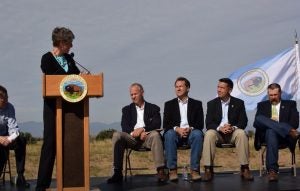This blog was co-authored by David Festa and Dan Grossman.
Two years ago, a colleague of ours penned a blog titled, “How Interior pick can make good on Trump’s promise to honor Theodore Roosevelt.”
Looking back now, it was optimistic for any of us to believe that Ryan Zinke could fulfill the responsibilities of the Interior Secretary, when it’s clear that the Trump administration has no respect for America’s natural resources and cultural heritage.
Here are three reasons why Zinke failed as Interior Secretary, and why we are deeply skeptical that his replacement will succeed, either.
- Promoting energy dominance above all else
As soon as President Trump signed his executive order on energy dominance, Zinke didn’t waste any time expanding oil and gas drilling on public lands at the expense of public health, vital wildlife habitat, and treasured landscapes.
The Bureau of Land Management’s methane waste rule required companies to minimize venting, flaring, and leaks from oil and gas operations on public lands. But the loss of these protections under Zinke’s watch has had immediate, harmful impacts on tribes, local communities, ranchers, and families – from the loss of tens of millions of dollars for local infrastructure projects, education and conservation, to more ozone pollution in places already struggling to meet federal air quality standards.

When oil and gas companies work to make their operations on federal and tribal lands more efficient and keep more natural gas in the sales lines instead of atmosphere, everybody wins.
Zinke also sacrificed key migratory and breeding habitats for species like the American antelope and greater sage-grouse, ignoring Westerners’ pleas and rolling back a decades-forged, bipartisan plan to keep the bird off the endangered species list.
The administration’s reckless expansion of oil and gas on public lands also encroached on national parks and monuments – iconic places, historic landmarks, and cultural sanctuaries designated for all Americans to enjoy, for generations to come.
- Disrespecting our nation’s bipartisan conservation legacy
The rollback of the sage-grouse plans was just the last in a series of efforts by Zinke to undermine America’s bipartisan conservation legacy – one that was shaped heavily by Republicans.
Zinke came into Interior claiming to be a Teddy Roosevelt Republican, but his department’s actions to roll back endangered species and mitigation policies were a disgrace not only to Roosevelt’s legacy, but also to the legacy of the late President George H. W. Bush, who established the no net loss of wetlands policy that dramatically slowed the loss of wetlands and spurred the development of a $25-billion ecological restoration economy that supports over 200,000 jobs.
Other Republican administrations worked prudently to establish and strengthen conservation policies to safeguard ecosystems and public health, including the Reagan administration, which adopted a seminal mitigation policy to avoid and offset harms to fish, wildlife, and plants.
Zinke showed no regard for these common sense conservation policies during his time at Interior, when he only weakened protections for land, water, and wildlife in ways that ultimately threatened jobs and the rural economy.

The collaborative conservation effort that led to a “not warranted” listing decision for the greater sage-grouse in September 2015 received bipartisan support from western governors.
- Putting the rural economy at risk
The Trump administration’s proposed changes to wildlife, mitigation, and methane waste policies will have negative economic impacts on the $25-billion mitigation and $887-billion recreation sectors, which directly support nearly 8 million American jobs.
Specifically, Zinke’s sage-grouse plan revisions are currently holding up millions of dollars invested in sage-grouse conservation programs – dollars that would otherwise be flowing to Western states for projects on the ground – and are also hurting outdoor recreation and tourism industries, which benefit from roughly $1 billion a year in economic output driven by sage-grouse.
Zinke’s own department analyses found that his methane waste policy changes will result in $1 billion more in wasted American energy and pollution costs – energy revenue that tribes and many other Western communities depend on to fund critical infrastructure such as schools, health clinics, roads, and more.
As long as the Trump administration is willing to ignore the economic and other interests of Westerners, tribes, and countless other Americans to favor the short-term interests of a few deep-pocketed industry lobbyists, we are not confident that anyone can fulfill the role of the Interior Secretary.
Three ways Zinke failed as Interior Secretary. Why the next Secretary will likely fail, too. Share on X









